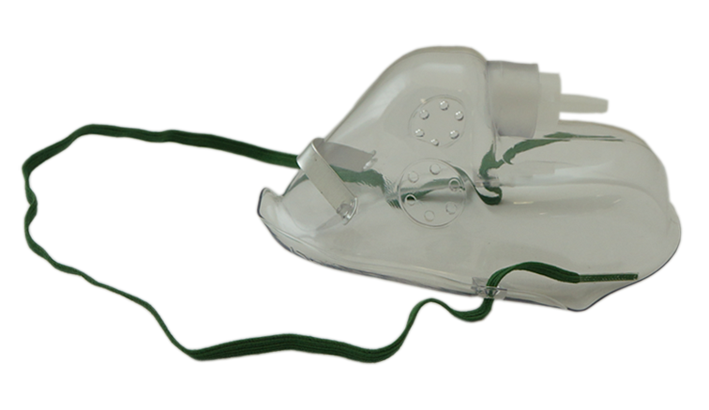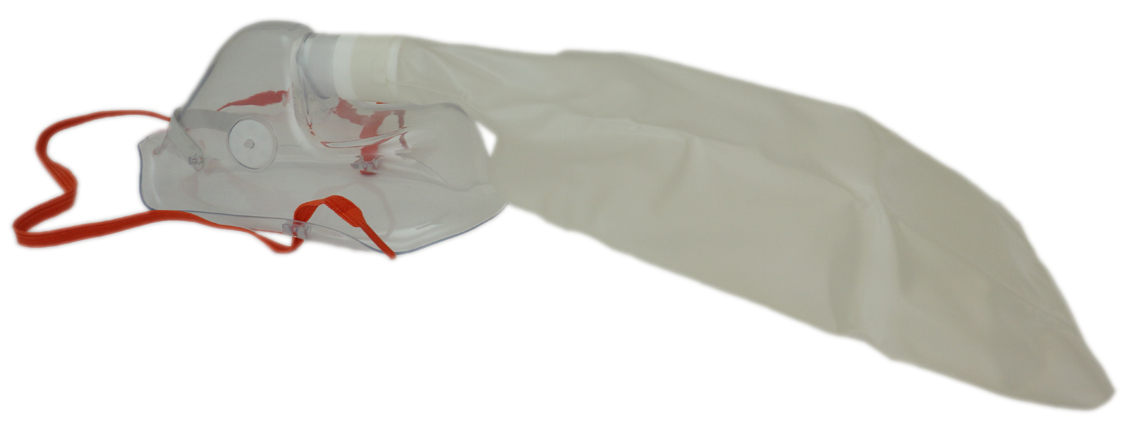
- To provide supplementary oxygen to patients who show clinical signs of low oxygen levels.
- N / A
- Crews are advised to limit the use of oxygen in patients with influenza like symptoms wherever possible to avoid aerosolisation.
- Crews are advised to tolerate lower SpO2 than usual in patients with ILI; ≥ 88% is acceptable. Note: It may not be possible to improve SpO2 to an acceptable level within the oxygenation guideline described above.
- Recommendations:
- Nasal prongs: 1-4 litres per minute, ideally with surgical mask over the top where possible
- Therapy mask: Maximum 10 litres per minute
- Non-rebreather/high concentration mask: Maximum 15 litres per minute
- Crews treating patients who are on home BiPAP/CPAP or with a tracheostomy should don full PPE requirements for aerosol generating procedures (AGP’s) if the presentation is an infective respiratory illness. See PPE requirements.
- Always turn the oxygen off first, then remove the nasal prongs/mask from the patient.
- All relevant infection control methods to be utilised.
- Prepare equipment required:
- Nasal cannula / therapy mask / non-rebreather mask
- Oxygen
- Oxygen tubing
- Explain the procedure to the patient.
- Select appropriate size and type of face mask required, either nasal cannula[1], the therapy mask[2] or the non-rebreathing mask[3].
Nasal Cannula
- Connect the face mask to the oxygen cylinder.
- Set flow rate at 1 to 4 litres per minute.
- Apply the nasal cannula to the patient's nose first; if the nasal prongs are curved, these should face posteriorly to the patient.
- Looping the tubing around the patients ears and bring it to the front of the patients chest.
- Move the slider up the tubes to adjust the fit. The nasal cannula should sit snugly under the chin with enough room to fit two fingers between the tubes and the patients chin.
- Refer to oxygen protocol
Therapy Mask
- Connect the face mask to the oxygen cylinder.
- Set flow rate at 5 to 8 litres per minute.
- Fit the face mask to the patient’s face and adjust the mask to comfort with elastic straps and nasal metal strip.
- Refer to oxygen protocol
Non-Rebreathing Mask
- Connect the face mask to the oxygen cylinder.
- Set flow rate at 10 to 15 litres per minute.
- Ensure the reservoir bag is fully inflated.
- Fit the face mask to the patient’s face and adjust the mask to comfort with elastic straps and nasal metal strip.
- Refer to oxygen protocol
1. Nasal Cannula
2. Therapy Mask
3. Non-rebreather Mask
- Constantly monitor the patient to ensure that the oxygen is having the desired effect, e.g. respiratory effort and SpO2 reading.
- N / A
- Claustrophobia.
- Drying effect on the mouth.
- Remove the mask from the patient’s face prior to turning off the oxygen supply.
Document Control
Clinical Resources Website
St John Ambulance Western Australia Ltd (ABN 55 028 468 715) (St John WA) operates ambulance and other pre-hospital clinical services. St John WA’s Clinical Resources, including its Clinical Practice Guidelines (Clinical Resources), are intended for use by credentialed St John WA staff and volunteers when providing clinical care to patients for or on behalf of St John WA, within the St John WA Clinical Governance Framework, and only to the extent of the clinician’s authority to practice.
Other users – Terms of Use
The content of the St John WA Clinical Resources is provided for information purposes only and is not intended to serve as health, medical or treatment advice. Any user of this website agrees to be bound by these Terms of Use in their use of the Clinical Resources.
St John WA does not represent or warrant (whether express, implied, statutory, or otherwise) that the content of the Clinical Resources is accurate, reliable, up-to-date, complete or that the information contained is suitable for your needs or for any particular purpose. You are responsible for assessing whether the information is accurate, reliable, up-to-date, authentic, relevant, or complete and where appropriate, seek independent professional advice.
St John WA expressly prohibits use of these Clinical Resources to guide clinical care of patients by organisations external to St John WA, except where these organisations have been directly engaged by St John WA to provide services. Any use of the Clinical Resources, with St John WA approval, must attribute St John WA as the creator of the Clinical Resources and include the copyright notice and (where reasonably practicable) provide a URL/hyperlink to the St John WA Clinical Resources website.
No permission or licence is granted to reproduce, make commercial use of, adapt, modify or create derivative works from these Clinical Resources. For permissions beyond the scope of these Terms of Use, including a commercial licence, please contact medservices@stjohnambulance.com.au
Where links are provided to resources on external websites, St John WA:
- Gives no assurances about the quality, accuracy or relevance of material on any linked site;
- Accepts no legal responsibility regarding the accuracy and reliability of external material; and
- Does not endorse any material, associated organisation, product or service on other sites.
Your use of any external website is governed by the terms of that website, including any authorisation, requirement or licence for use of the material on that website.
To the maximum extent permitted by law, St John WA excludes liability (including liability in negligence) for any direct, special, indirect, incidental, consequential, punitive, exemplary or other loss, cost, damage or expense arising out of, or in connection with, use or reliance on the Clinical Resources (including without limitation any interference with or damage to a user’s computer, device, software or data occurring in connection with such use).
Cookies
Please read this cookie policy carefully before using Clinical Resources from St John WA.
The cookies used on this site are small and completely anonymous pieces of information and are stored on your computer or mobile device. The data that the cookies contain identify your user preferences (such as your preferred text size, scope / skill level preference and Colour Assist mode, among other user settings) so that they can be recalled the next time that you visit a page within Clinical Resources. These cookies are necessary to offer you the best and most efficient possible experience when accessing and navigating through our website and using its features. These cookies do not collect or send analytical information back to St John WA.
Clinical Resources does integrate with Google Analytics and any cookies associated with this service enable us (and third-party services) to collect aggregated data for statistical purposes on how our visitors use this website. These cookies do not contain personal information such as names and email addresses and are used to help us improve your user experience of the website.
If you want to restrict or block the cookies that are set by our website, you can do so through your browser setting. Alternatively, you can visit www.internetcookies.com, which contains comprehensive information on how to do this on a wide variety of browsers and devices. You will find general information about cookies and details on how to delete cookies from your device. If you have any questions about this policy or our use of cookies, please contact us.